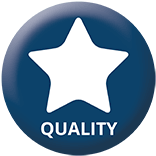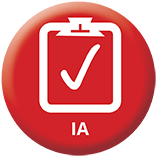Merit-based Incentive Payment System (MIPS)
2024 is the eighth year for the Quality Payment Program (QPP). Many radiation oncologists will continue to participate in the Merit-based Incentive Payment System (MIPS). Based on an eligible clinician’s performance in four categories in 2024, their 2026 Medicare Part B reimbursement will be impacted.
The rules and requirements have changed each year of the MIPS program. Below is a list of major highlights for the new year:
- Increased performance period for Promoting Interoperability to a minimum of 180 days.
- Addition of Tobacco Use quality measure to radiation oncology measure set.
- Payment adjustment is +/-9%.
- Performance threshold remains at 75 points.
Physicians can look up eligibility on the QPP Participation Lookup tool based on their National Provider Identification (NPI) number.
There are many requirements and rules in MIPS, however there is still a large amount of flexibility for participating in the program.
Traditional MIPS, established in the first year of the Quality Payment Program, is the original reporting option available to MIPS eligible clinicians for collecting and reporting data to MIPS. Your performance is measured across 4 areas: quality, improvement activities, promoting interoperability, and cost.
In addition to traditional MIPS, two other MIPS reporting frameworks, designed to reduce reporting burden, are available to MIPS eligible clinicians.
The APM Performance Pathway (APP), designed to reduce reporting burden, creates new scoring opportunities for participants in MIPS APMs, and encourages participation in APMs. This reporting option is available to MIPS eligible clinicians identified on an APM Participation List or Affiliated Practitioner List of an APM Entity participating in any MIPS APM on any of the four snapshot dates (March 31, June 30, August 31, and December 31) during a performance year.
MIPS Value Pathways (MVPs) are the newest reporting option to fulfill MIPS reporting requirements. To begin preparing, review the steps below. There are 16 MVPs available for reporting in the 2024 performance period. Learn more.
Performance Categories
An eligible clinician or group’s overall payment adjustment is based on the Composite Performance Score (CPS). For 2024, the CPS score is based on four performance categories: Quality, Promoting Interoperability, Improvement Activities and Cost. There are specific circumstances where a practice may not qualify for a certain performance category. In these cases, the weight of that performance category will be reweighted to another category.
 | The Quality performance category typically comprises 30% of the CPS. Six quality measures are required unless your practice chooses to report the radiation oncology measure set. Data completeness rules for 2024 require a full year of reporting and at least 75 percent of patients that meet the measure’s denominator criteria, regardless of payer, with a minimum of 20 cases. |
If you choose to submit a specialty measure set, you must submit data on at least six measures within that set. If the set contains fewer than six measures, you should submit each measure in the set. The Radiation Oncology Specialty Measure Set includes four measures with the 2023 addition of Tobacco Use.
| Quality ID | Measure | High Priority* Measure? | Reporting |
|---|---|---|---|
| 102 | Avoidance of Overuse of Bone Scan for Staging Low Risk Prostate Cancer Patients | Yes |
Registry EHR |
| 143 | Pain Intensity Quantified | Yes |
Registry EHR |
| 144 | Plan of Care for Pain |
Yes |
Registry |
| 226 | Tobacco Use: Screening and Cessation Intervention |
Yes |
Registry EHR Claims |
CMS determines measure achievement points by comparing performance on a measure to a measure benchmark.
If a measure can be reliably scored against a benchmark, it means:
- A benchmark is available;
- Case minimum criteria has been met (measure had a submission of at least 20 cases (for most measures)); and
- Data completeness criteria has been met (performance data reported for at least 75% of the denominator eligible patients/cases).
 | The Promoting Interoperability (PI) performance category comprises 25% of the CPS. Hospital-based clinicians are exempt from this category and non-hospital based clinicians can apply for a hardship exemption based on certain criteria. An exemption or hardship reduces the PI category to zero and increases the Quality category weight. |
One clinician type and several special status designations result in automatic reweighting. These clinicians, groups, virtual groups, and APM Entities are exempt from reporting Promoting Interoperability data for the 2024 performance year:
- Clinician type: clinical social workers
- Special status: ambulatory surgical center (ASC)-based, hospital-based, non-patient facing, and small practice (Note: small practice is the only special status available to APM Entities.)
Individuals, groups, and virtual groups may submit a MIPS Promoting Interoperability Performance Category Hardship Exception application, citing one of the following reasons for review and approval:
- MIPS eligible clinician using decertified EHR technology (decertified under the ONC Health IT Certification Program)
- Insufficient internet connectivity
- Extreme and uncontrollable circumstances
- Lack of control over the availability of CEHRT
If your hardship exception is approved, the Promoting Interoperability performance category will receive a weight of 0% when calculating your final score and the 25% will be redistributed to another performance category (or categories) unless you submit data for the Promoting Interoperability performance category. Learn more.
Physicians and/or practices are required to use an Electronic Health Record (EHR) that meets the certification criteria at 45 CFR 170.315 for participation in this performance category to align with the Office of the National Coordinator for Health Information Technology (ONC)’s current and future regulation.
Clinicians must submit collected data for certain measures from each of the objectives (unless an exclusion is claimed) for the same 180 continuous days (or more).
More information on the specific measures can be found on the CMS website.
For measures that require a numerator and denominator, we calculate the performance rate for each measure using the numerators and denominators you submitted, and then multiply the performance rate by the total points available for the measure or objective. For scored measures that require a "yes" or "no," we award full points for measures submitted with a "yes."
For the Public Health and Clinical Data Exchange objective, you’ll be awarded full points if a “yes” is submitted for the two required measures (Immunization Registry Reporting and Electronic Case Reporting) or one “yes” and one exclusion. You’re also required to submit your level of active engagement for these two measures.
You must report all required measures (submit a “yes”/report at least one patient in the numerator, as applicable, or claim an exclusion) or you’ll earn a zero for the Promoting Interoperability performance category.
If exclusions are claimed, the points for those measures will be reallocated to other measures.
Bonus Points
You can earn five bonus points for submitting a "yes" response for one of the optional Public Health and Clinical Data Exchange measures (Public Health Registry Reporting, Clinical Data Registry Reporting, or Syndromic Surveillance Reporting).
 | The Improvement Activities (IA) performance category comprises 15% of the CPS. Activities are weighted as medium, worth 10 points, or high, worth 20 points. Clinicians must complete activities for at least 90 consecutive days. The number of activities/points needed depends on practice location and size. RO-ILS and APEx can help satisfy the IA category requirements. |
How activities are weighted is an important factor in determining the score and how best to satisfy the minimum requirements. For a full list of the activities, visit CMS’s QPP website.
While only attestation of activity completion is necessary for reporting, practices should maintain documentation to demonstrate consistent and meaningful engagement within the performance period. In the event of an audit, documentation must be presented.
RO-ILS: Radiation Oncology Incident Learning System®, sponsored by ASTRO and AAPM, is a part of Clarity PSO, a federally listed patient safety organization, which meets the requirement for the “Participation in an AHRQ-listed patient safety organization" activity. There is no fee to participate in RO-ILS, but the facility must sign an agreement with Clarity PSO so start the contracting process now. Join the more than 800 facilities enrolled in RO-ILS.
ASTRO’s APEx - Accreditation Program for Excellence focuses on a culture of quality and safety, as well as patient-centered care. Evidence Indicators required for APEx Accreditation map to 15 different improvement activities. The APEx Self-Assessment can satisfy all the requirements for the Improvement Activities Performance Category.
To earn full credit in this performance category, you must generally submit one of the following combinations of activities:
- Two high-weighted activities
- One high-weighted activity and two medium-weighted activities
- Four medium-weighted activities
High-weighted activities receive 20 points and medium-weighted activities receive 10 points. There is a maximum of 40 points that can be earned from attesting to activities in this performance category.
Special Status
You will receive double points for each high- or medium-weighted activity you submit if you are an individual clinician, group, virtual group, or APM Entity that holds a qualifying special status. You can check for any special status by signing in.
 | The Cost performance category comprises 30% of the final score. Currently two cost measures are in the performance category: Medicare Spending Per Beneficiary (MSPB) and Total Per Capita Cost (TPCC). Providers do not report data, as CMS will use administrative claims to attribute patients and costs to providers. If CMS cannot calculate a cost score for a physician/group, then the Cost category is reduced to zero. |
The MIPS Cost category includes episode-based measures for acute and chronic conditions, as well as population-based measures that take a broader view focused on primary care.
Radiation oncology practices may be scored on the Medicare Spending per Beneficiary cost measure, but typically are not unless they are large practices that meet the necessary patient counts for inclusion.
Episodes will be attributed to the clinician who provided the Part A and Part B services to a beneficiary during the admission.
- Clinicians who do not see patients in the hospital will not be attributed to any episodes and not scored on the measure.
- Clinicians must be attributed to at least 35 cases to be scored on the measure.
You will be evaluated and scored on each cost measure for which you meet or exceed the established case minimum. CMS determines measure achievement points by comparing performance on a measure to a performance period benchmark. CMS calculates cost measure benchmarks using performance data from the performance period, rather than historical data.
You must meet the established case minimum for and be scored on at least one measure to receive a cost performance category score.
Facility-Based Scoring
Facility-based scoring may be applied to facility-based clinicians, groups and virtual groups.
Facility-based scoring will be used for your quality and cost performance category scores when all the following conditions are met:
- You are identified as facility-based.
- You are attributed to a facility with the fiscal year Hospital Value-Based Purchasing (VBP) Program score.
- The facility-based scoring methodology using your Hospital VBP Program score results in a higher final score than your final score calculated without the application of facility-based measurement.
Contact [email protected] with questions.


